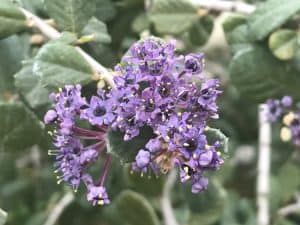The late winter manzanita flowers and early spring bloom on gooseberries and currants: provision for hummingbirds – all the sugar energy they need to think about building nests and starting families. Right now many deciduous trees and shrubs are bare, allowing precious winter light to reach the understory plants, plants that will surely appreciate the same tree’s shade a few months from now. And you can see the first signs of flower buds on your sage, sunflower, and even a few of the early Ceanothus.
As we slowly round the corner on an approach toward spring, we will be leaving winter behind. That would be a typical February outlook. Today it feels like summer though. This has not been a typical January. At today’s writing (1/28/18) it is 87° again and the Santa Anas are still blowing. The forecast says, “No rain in sight.” All this after a season total to date of less than 3” rain, most of which came in one storm in early January. Sierra snowpack at 30% normal for the date. If this windy heatwave keeps up, what little seasonal soil moisture we got will be all gone. Is this the new normal?

Watering
Even if we were to get copious rains in March and April, we need to water now, because the dry, hot, windy weather is drying the soil and our plants are transpiring… the term used to describe the action of plants in using water to cool themselves. Replace the lost water and add plenty of additional moisture to the soil root zone, so the plants can soon commence their spring growth.
Related to Watering
Follow the instructions in our Watering Guide as if you were watering dry soil (You probably are!) Apply the equivalent of 1.5-2” or rainfall. This is one of those years when we need to apply cool season water to substitute for rain we are not getting.
Pruning
You can do all the garden clean-up, thinning, heading back, and shaping you want. The most important issue would be to carefully examine the branch tips. You don’t want to cut off spring bloom, but is most cases, February is early enough to finish any pruning you have not done yet.
Weeding
As the soils slowly start to warm, you will see germination of a few weed species, or maybe even more than a few. As you know, weeds are a lot easier to deal with when they are small. Cut, pull or cultivate to eliminate weeds as they emerge. If you sowed a wildflower seed mix, it will be difficult to distinguish the weeds from the flowers. Hopefully you have all flowers.
Mulching/Top dress
This season is still best for using the fallen leaves from your deciduous trees on any bare soil that you want to top dress. If you have a little garden leaf shredder, you can spread a really nice home made (sustainable) mulch. Remember the goal with mulch is to get your garden to a place where it is making its own… mature plants whose leaves and branches are shading the soil and whose fallen leaves provide self sustaining organic matter on the root zone.
Feeding
Now is time to feed all your potted plants. Use a water soluble liquid organic (i.e.; fish emulsion) or a commercial fertilizer (i.e.; Miracle Gro) to give your patio plants an early boost.
Troubleshooting – Varmints, Pests and Diseases
While you’re out pruning and cleaning up, keep an eye out for old problems like last year’s residual scale insects, rust, or stem canker. Prune it off and sanitize your shears in 10% bleach solution. Also you can watch for signs of new infestations of scale or mealybug insects, or mildew (powdery or downy) which make leaf spots and rotten brown leaves.
Toyon had a particularly rough time last year and now show signs of diseased and dead branches. A TOLN customer got a diagnosis from CDFA on his toyon with branch die back. Thanks for sharing it with us, Alex: “Sooty canker, Neoscytalidium dimidiatum present on cankered areas. This fungus is an opportunistic pathogen on stressed woody hosts, often invading through wounds. Very wide host range.” Look for bark peeling off on your brown toyon branches. Prune them off by cutting into healthy wood and sanitizing your shears between cuts. Discard the branches away from your garden.
Annual Wildflowers
If you haven’t done so already it is still not too late to sow seed, however we are getting close to the time when that window closes. If you sowed seed earlier, you can tend your little seedlings. With the current lack of rain, keep them fresh with a light sprinkle now and then.
Adding New Plants
February and March are the ideal months for planting natural gardens. Plant California native plants now. Period.
Engage
This month you can watch the buds swell, spiders hatch, and songbirds preparing to build nests. The late winter evening light is great for close-up photography, and the red skies on those crisp pre-dawn mornings can’t be beat for backdrop as you appreciate or photograph the “wake up” moments your garden. Watering (as needed) makes for fine therapy, though rain would be better, in which case you could get all the therapy you need by just drawing deep breaths and taking in all the scents of a natural garden at the verge of spring. So pray for rain.
From the Garden,
Mike Evans
Questions? Help is just one call or one email away. Call (949) 728-0695 or email (with pictures if you like) our brand new help email: gardenhelp@californianativeplants.com.